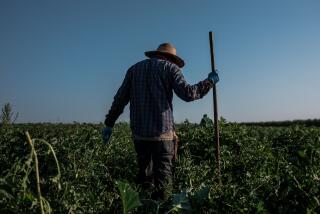Price Supports Blamed for the Plight of U.S. Farmers
- Share via
NEW YORK — A simple financial problem might help explain at least one facet of the farm problem, the economist said. And that, he suggested, is real progress, even if painful decisions still remain.
How much, asked Prof. William Dunkelberg of Purdue University, would you be willing to pay for a piece of paper that guaranteed you $100 a year?
“A thousand dollars” came the reply.
“Fair enough,” Dunkelberg said. “That would give you a return of 10% a year forever.”
Assume, he continued, that another person then offered you $200 a year for that paper. “How much more would the paper be worth?”
He didn’t wait for an answer. “Assuming a 10% return,” he said, “the paper would then be worth $2,000.”
Now, he said, “substitute an acre of land for the paper and government price supports for the promise of $100--and then $200--and one aspect of the farm problem is clear.”
What is clear, he concluded, is that government subsidies in the form of price guarantees drove up acreage prices for thousands of farmer-buyers who now cannot afford to finance them.
That insight, unfortunately, illustrates only one part of a problem fraught with philosophical, political, financial and human dimensions. And the problem, he said, will require tough decisions too.
To understand the farm problem, he said, you must be aware of several facts.
- The economy has produced many “victims.”
They include millions of retired people who lost their savings to inflation. And homeowners who must make mortgage payments at high interest rates. And small-business people who lost their businesses in the last recession.
- Any assistance must ultimately come out of the taxpayer’s pocket.
- The nation’s resources are limited. “If the have-nots are to get more, the haves must take less. That is an economic law that cannot be broken.”
- Much of the farm dilemma is a result of farm policy.
Consider the piece of paper that jumped in price to $2,000 from $1,000, Dunkelberg said. And, he said, dwell on the fact that half of 1983 farm income came from subsidies, “though U.S. farmers are the world’s most efficient.”
Those subsidies attracted new entrants into farming, the professor said. “And every time the new entrants got into financial trouble we would raise the support prices--and land values would follow.”
Now, he said, about 8% of farmers owe 30% of the farm debt. “We have too many farmers producing too much output because of the support programs,” he said.
If the country were to abandon price supports, he continued, financial “inputs” would be restructured to reflect true market conditions and production costs.
“The most efficient, low-cost producers would prevail, and the less efficient would exit the industry,” Dunkelberg said.
“All of us, including poor people, then would get the lowest-cost food possible, and our farmers could compete in world markets.”
As matters stand, he argued, “inefficient foreign growers will continue to enter the world farming business and underprice us, even if the dollar decreases in value.”
Therefore, he said, the problem can be distilled to two considerations:
- What policy course should we follow to establish a healthy farm industry?
- What should we do about those current farmers harmed by a change in policy?
“We must treat these problems separately,” Dunkelberg said. But separately or together, the decisions to be faced are painful. There is no easy way out, he said.
More to Read
Inside the business of entertainment
The Wide Shot brings you news, analysis and insights on everything from streaming wars to production — and what it all means for the future.
You may occasionally receive promotional content from the Los Angeles Times.










